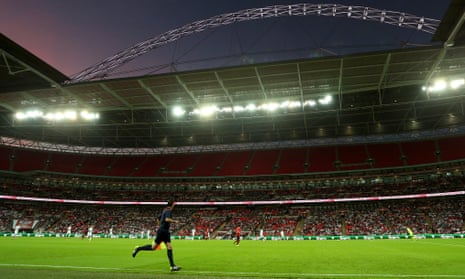Uefa has confirmed which teams are in each of the four leagues for the inaugural Nations League, European football’s new international competition intended to replace most friendlies.
Based on the coefficient rankings after the group stages of the European qualifiers for Russia 2018, England, ranked sixth, are in League A, while Wales (14th), the Republic of Ireland (19th) and Northern Ireland (21st) are in League B, and Scotland (27th) are in League C. All 55 Uefa nations are assigned to a league, with 12 teams in A and B, 15 in C and 16 in D.
At a draw in Lausanne on 24 January, each league will then be divided into four groups of either three or four nations and they will play each other home and away from September to November next year. A promotion and relegation system will operate between the leagues – four up, four down – and the second edition of the competition is scheduled to start in September 2020.
The winners will be decided at a tournament between the nations that finish top of the four League A groups in June 2019, with semi-finals, a third-place match and a final to be held in one of the finalist countries.
Uefa has introduced the competition to revive international football with more competitive matches and to give countries more chances to play against teams of a comparable standard. But many fans, players and pundits have expressed some confusion over the idea, particularly as it will run alongside qualifying for the 2020 European Championship.
That process will now begin in March 2019, with countries split into 10 groups of five or six, and the top two teams in each group qualifying for the finals. The major change, however, is that the final four places will be decided via play-offs between the winners of the 16 Nations League groups in 2018.
Each league – A to D – will have its own play-off competition with single-leg semi-finals and a final to decide who wins the place. The draw for those play-offs will take place in November 2019 and the play-offs themselves will occur in March 2020.
If the winners of a Nations League group have already qualified for Euro 2020 via the qualifying groups, their place in the play-off will go to the next best team in their Nations League group that has not secured a place. If a league still does not have enough teams for a play-off, as is entirely possible for League A, the places will be filled by the best-ranked teams from the league below.
Uefa Nations League sections
League A Germany, Portugal, Belgium, Spain, France, England, Switzerland, Italy, Poland, Iceland, Croatia, Holland.
League B Austria, Wales, Russia, Slovakia, Sweden, Ukraine, Republic of Ireland, Bosnia-Herzegovina, Northern Ireland, Denmark, Czech Republic, Turkey.
League C Hungary, Romania, Scotland, Slovenia, Greece, Serbia, Albania, Norway, Montenegro, Israel, Bulgaria, Finland, Cyprus, Estonia, Lithuania.
League D Azerbaijan, Macedonia, Belarus, Georgia, Armenia, Latvia, Faroe Islands, Luxembourg, Kazakhstan, Moldova, Liechtenstein, Malta, Andorra, Kosovo, San Marino, Gibraltar.
